Study on Characteristics of Steam Chamber and Factors Influencing Nitrogen-Assisted Vertical–Horizontal Steam Drainage Development
Abstract
:1. Introduction
2. Factors Influencing VHSD and Contribution Analysis
2.1. Evaluation Indicator
2.2. Validation of the Relationships between Influencing Factors
2.3. Analysis of Evaluation Results
3. Two-Dimensional Physical Simulation Experiment of VHSD
3.1. Similarity Criteria Modification
3.2. Experimental Design
3.2.1. Experimental Instruments and Materials
3.2.2. Experimental Model
3.2.3. Experimental Scheme
3.3. Analysis of Experimental Results
4. Conclusions
Author Contributions
Funding
Data Availability Statement
Conflicts of Interest
References
- Butler, R.M.; Stephens, D.J. The gravity drainage of steam-heated heavy oil to parallel horizontal wells. J. Can. Pet. Technol. 1981, 20, 90–96. [Google Scholar] [CrossRef]
- Hongzhao, T.; Ye, S. Operation parameters optimization of steam flooding with the combination of vertical and horizontal wells. Lithol. Reserv. 2013, 25, 127–130. [Google Scholar]
- Yun-Peng, Z.; Geng-Cheng, Y.; Gang, Z.; Zhi-Guo, W.; Zi-Qi, Z.; Wen-Zhe, Y. Principle and application of numerical simulation analysis of vertical well and horizontal well assisted gravity drainage. Sci. Technol. Eng. 2021, 21, 12916–12924. [Google Scholar]
- Changhong, Z.; Xinge, S.; Yingbo, L.U.; Li, W.; Pengcheng, H.U.; Xiangrong, X.; Guiqing, W. Physical simulation experiment of steam chamber evolution in compound development of thin-layer ultra-heavy oil flooding and drainage. Lithol. Reserv. 2023, 35, 161–168. [Google Scholar]
- Butler, R. The steam and gas push (SAGP). J. Can. Pet. Technol. 1999, 38, 47–54. [Google Scholar] [CrossRef]
- Butler, R.M.; Jiang, Q.; Yee, C. Steam and gas push (SAGP); 4, recent theoretical developments and laboratory results using layered models. J. Can. Pet. Technol. 2001, 40, 54–61. [Google Scholar] [CrossRef]
- Yuan, Z.; Liu, P.; Zhang, S.; Li, X.; Shi, L.; Jin, R. Experimental study and numerical simulation of nitrogen-assisted SAGD in developing heavy oil reservoirs. J. Pet. Sci. Eng. 2018, 162, 325–332. [Google Scholar] [CrossRef]
- Zhang, S.; Li, X.; Jiang, Y.; Zhang, Z.; Sun, X.; Wang, H. Physical modeling of nitrogen slug operation in Xinjiang SAGD projects—Fundamental roles of NCG in SAGD process. J. Pet. Sci. Eng. 2021, 203, 108642. [Google Scholar] [CrossRef]
- Butler, R.M. Thermal Recovery of Oil and Bitumen; Prentice Hall: Englewood Cliffs, NJ, USA, 1991. [Google Scholar]
- Dong, X.; Liu, H.; Hou, J.; Chen, Z.; Zhang, T. An empirical correlation to predict the SAGD recovery performance. J. Comput. Methods Sci. Eng. 2017, 17, 333–345. [Google Scholar] [CrossRef]
- Yang, G. Experimental study on physical simulation of the effect of reservoir thickness on SAGD in l oilfield. China Pet. Chem. Stand. Qual. 2016, 36, 48–49. [Google Scholar]
- Baker, R.; Fong, C.; Li, T.; Bowes, C.; Toews, M. Practical considerations of reservoir heterogeneities on SAGD projects. In Proceedings of the International Thermal Operations and Heavy Oil Symposium, Calgary, AB, Canada, 20–23 October 2008. [Google Scholar]
- Siavashi, M.; Garusi, H.; Derakhshan, S. Numerical simulation and optimization of steam-assisted gravity drainage with temperature, rate, and well distance control using an efficient hybrid optimization technique. Numer. Heat Transf. Part A Appl. 2017, 72, 721–744. [Google Scholar] [CrossRef]
- Mir, H.; Siavashi, M. Whole-time scenario optimization of steam-assisted gravity drainage (SAGD) with temperature, pressure, and rate control using an efficient hybrid optimization technique. Energy 2022, 239, 122149. [Google Scholar] [CrossRef]
- Patel, R.G.; Trivedi, J.J. Nonlinear model predictive control of steam-assisted-gravity-drainage well operations for real-time production optimization. SPE Prod. Oper. 2020, 35, 564–578. [Google Scholar] [CrossRef]
- Sasaki, K.; Akibayahsi, S.; Yazawa, N.; Doan, Q.; Ali, S.F. Numerical and experimental modelling of the steam assisted gravity drainage (SAGD) process. J. Can. Pet. Technol. 2001, 40, 44–50. [Google Scholar] [CrossRef]
- Saikia, B.D.; Rao, D.N. A single-well gas-assisted gravity drainage enhanced oil recovery process for U.S. Deepwater gulf of mexico operations. Energies 2021, 14, 1743. [Google Scholar] [CrossRef]
- Tao, L.; Yuan, X.; Cheng, H.; Li, B.; Huang, S.; Zhang, N. Experimental study on well placement optimization for steam-assisted gravity drainage to enhance recovery of thin layer oil sand reservoirs. Geofluids 2021, 2021, 1–18. [Google Scholar] [CrossRef]
- Jiang, Q. The steam and gas push (SAGP)-2: Mechanism analysis and physical model testing. In Proceedings of the Annual Technical Meeting, Calgary, AB, Canada, 8–11 June 1998. [Google Scholar]
- Pichugin, Z.; Chekhonin, E.; Popov, Y.; Kalinina, M.; Bayuk, I.; Popov, E.; Spasennykh, M.; Savelev, E.; Romushkevich, R.; Rudakovskaya, S. Weighted geometric mean model for determining thermal conductivity of reservoir rocks: Current problems with applicability and the model modification. Geothermics 2022, 104, 102456. [Google Scholar] [CrossRef]
- Kutcherov, V.G.; Serovaiskii, A.Y. Thermal conductivity of oil fractions at high pressure. Chem. Tech. Fuels Oils 2023, 58, 1094–1096. [Google Scholar] [CrossRef]
- Vogel, E.; Bich, E.; Hellmann, R. Determination of the binary diffusion coefficients and interaction viscosities of the systems carbon dioxide–nitrogen and ethane–methane in the dilute gas phase from accurate experimental viscosity data using the kinetic theory of gases. Int. J. Thermophys. 2023, 44, 129. [Google Scholar] [CrossRef]
- Yang, Y.; Peng, X.; Zhang, J.; Hao, H. Experimental research on the effect of residual oil saturation on fire flooding development in the late stage of steam injection. In Springer Series in Geomechanics and Geoengineering; Springer: Singapore, 2021; pp. 649–658. [Google Scholar]
- Krivova, N.R. Research results to determine residual oil saturation under steam treatment of the high-viscosity oil pool. EurAsian J. Biosci. 2019, 13, 1335–1342. [Google Scholar]
- Gong, H.; Yu, C.; Jiang, Q.; Su, N.; Zhao, X.; Fan, Z. Improving recovery efficiency by CO2 injection at late stage of steam assisted gravity drainage. Adv. Geo-Energy Res. 2022, 6, 276–285. [Google Scholar] [CrossRef]
- Li, S.; Yu, T.; Li, Z.; Zhang, K. Experimental investigation of nitrogen-assisted SAGD in heavy-oil reservoirs: A two-dimensional visual analysis. Fuel 2019, 257, 116013. [Google Scholar] [CrossRef]
- Yaseen, M.; Rawat, S.K.; Khan, U.; Sarris, I.E.; Khan, H.; Negi, A.S.; Khan, A.; Sherif, E.S.M.; Hassan, A.M.; Zaib, A. Numerical analysis of magnetohydrodynamics in a Eyring-Powell hybrid nanofluid flow on wall jet heat and mass transfer. Nanotechnology 2023, 34, 485405. [Google Scholar] [CrossRef] [PubMed]
- Noori Rahim Abadi, S.M.A.; Mehrabi, M.; Meyer, J.P. Numerical study of steam condensation inside a long, inclined, smooth tube at different saturation temperatures. Int. J. Heat. Mass. Transf. 2018, 126, 15–25. [Google Scholar] [CrossRef]



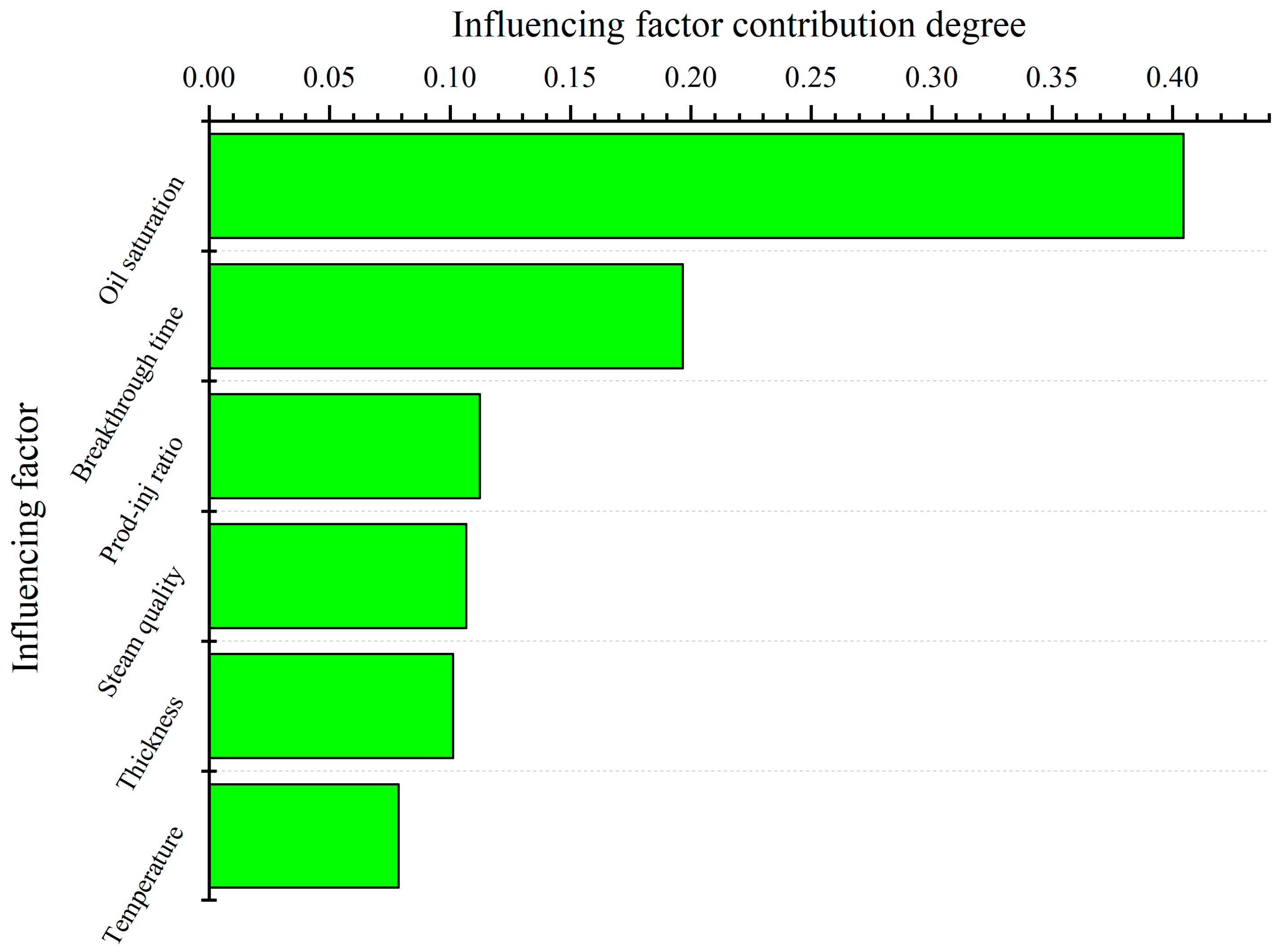
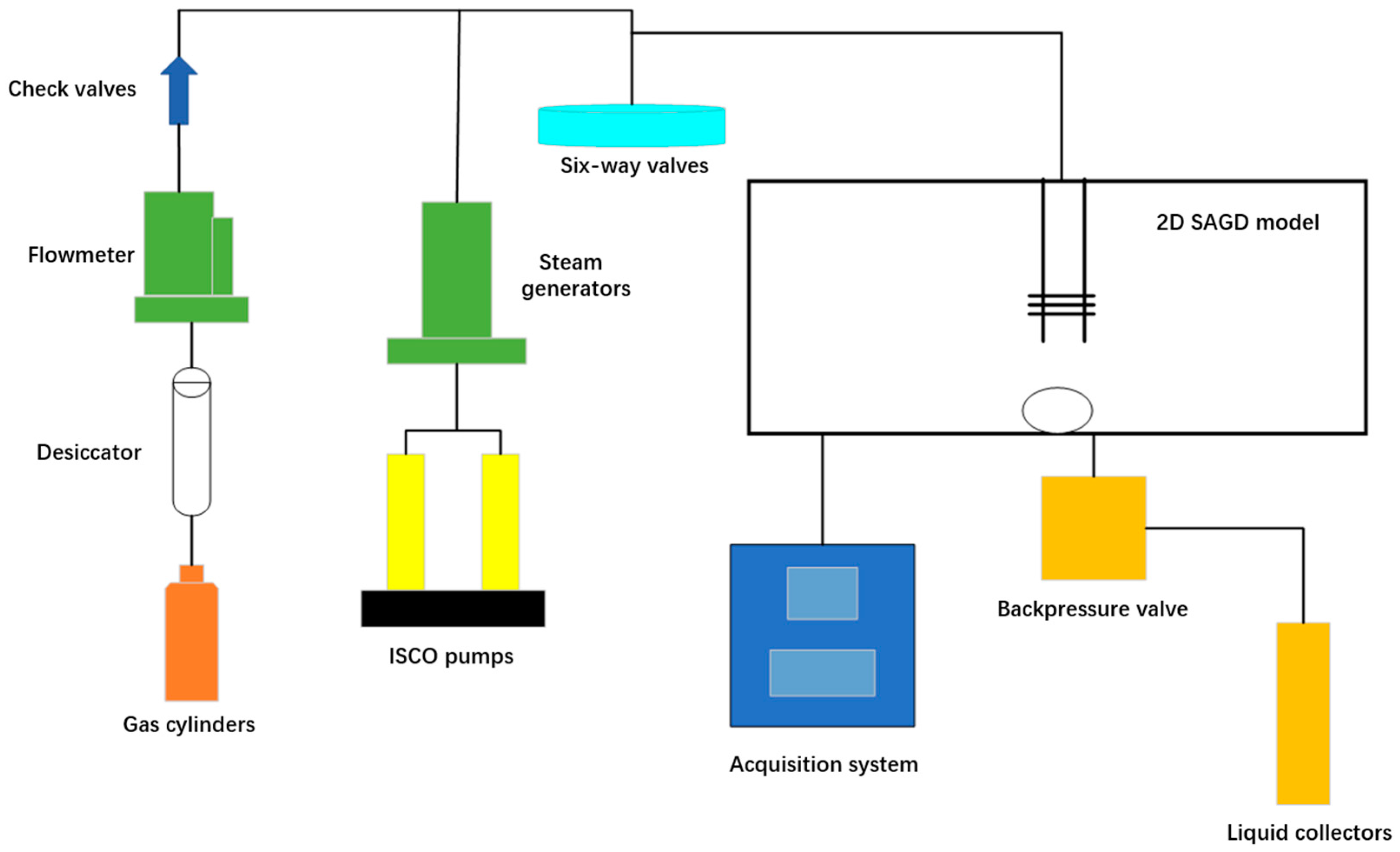


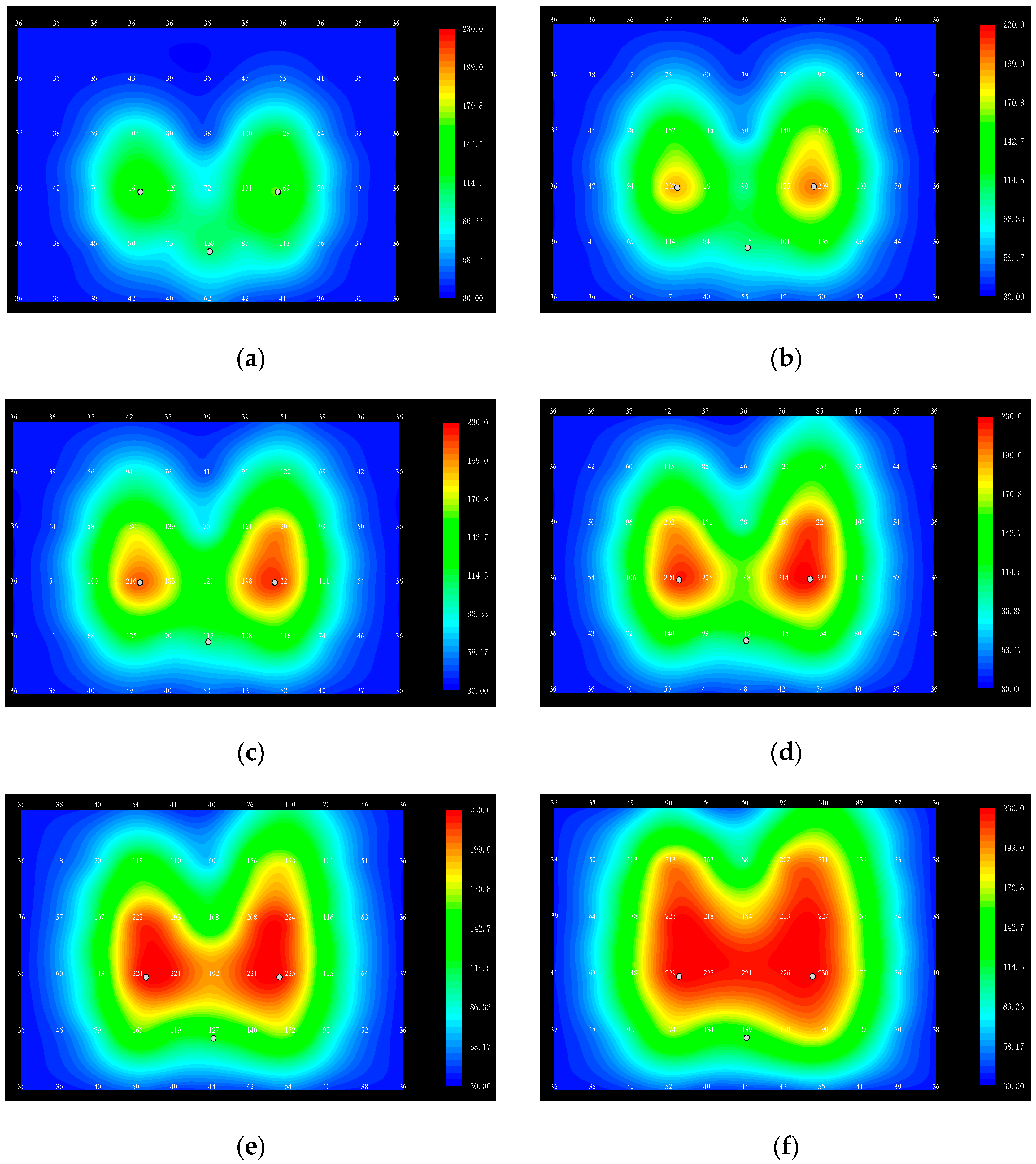

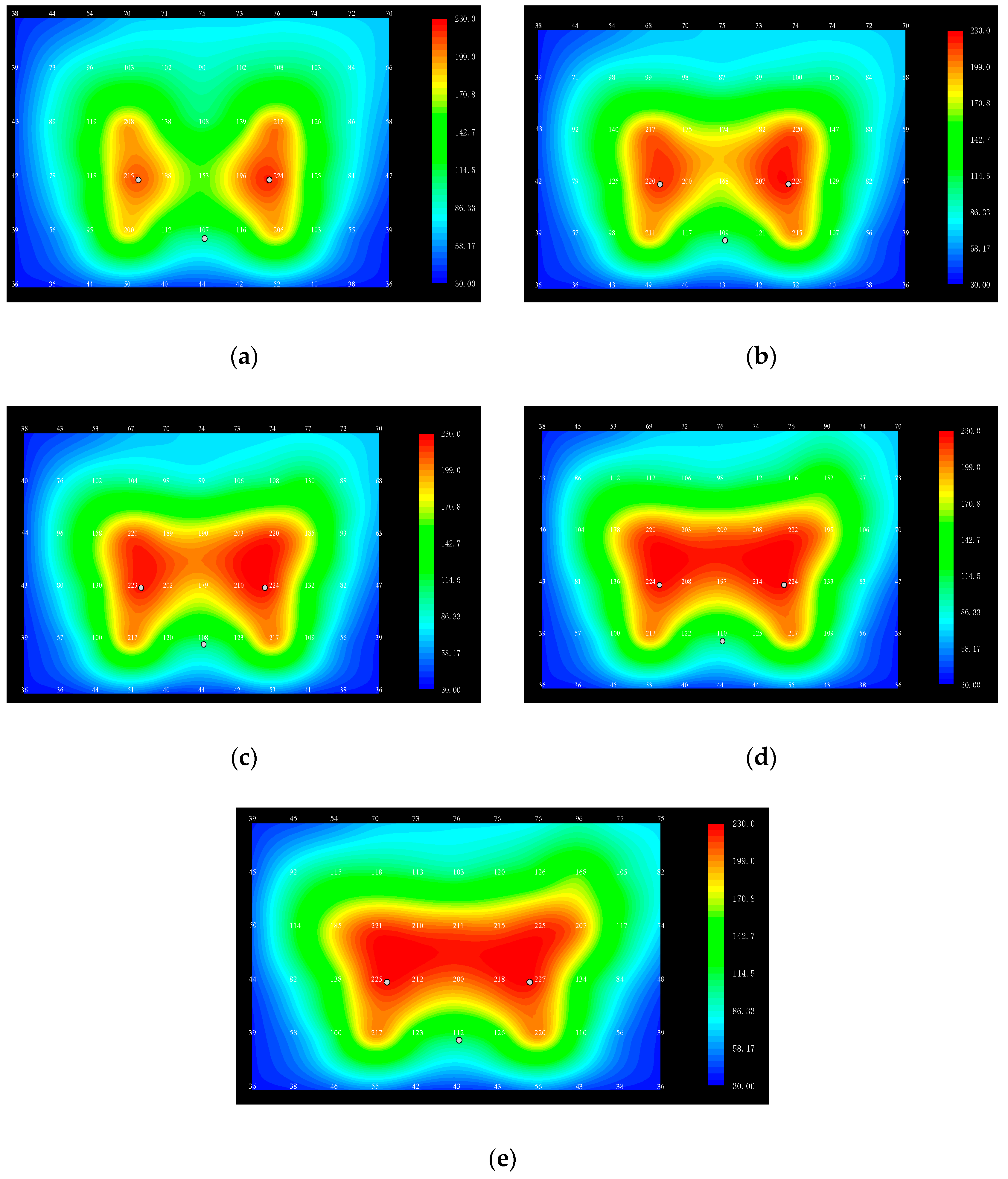
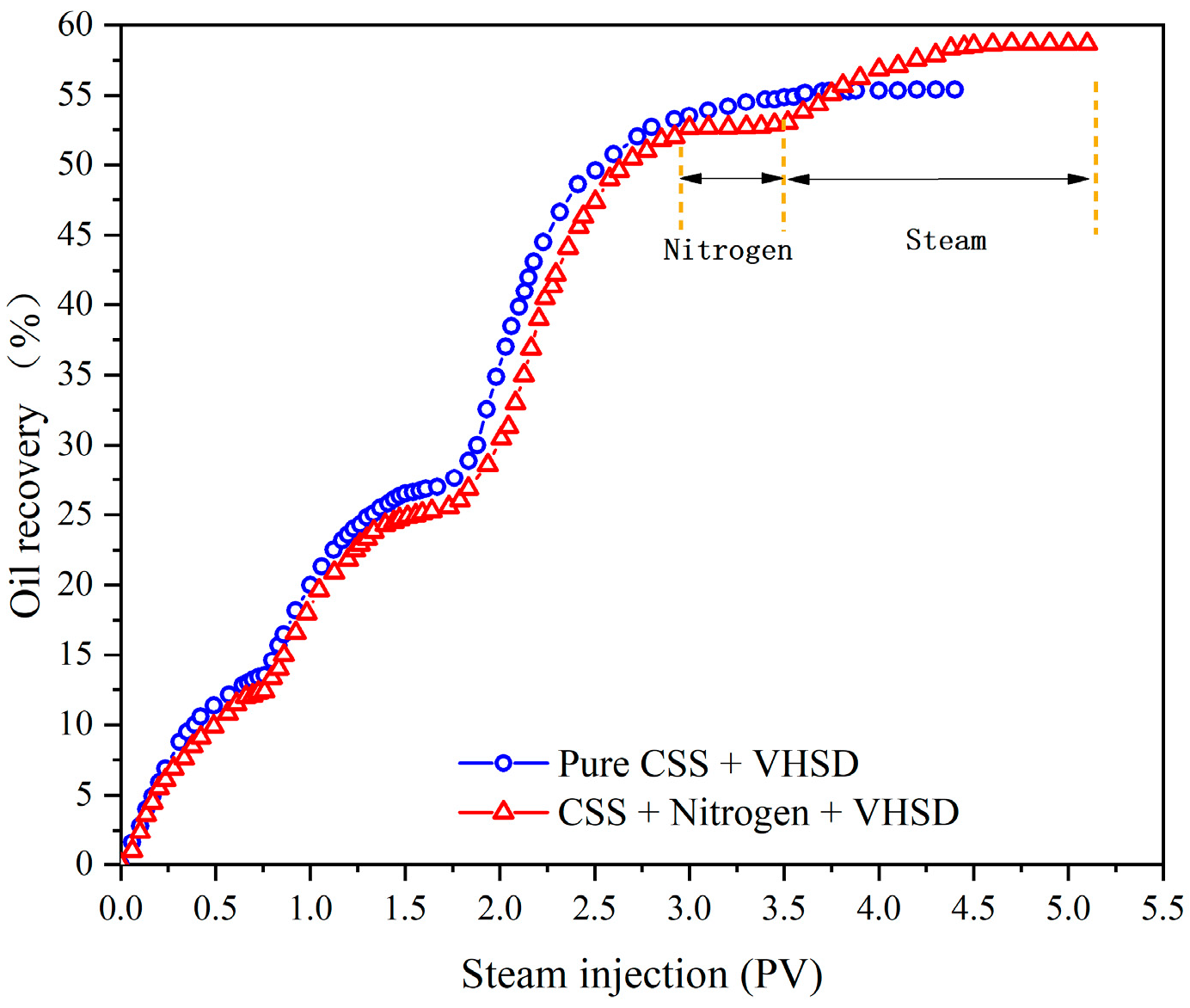

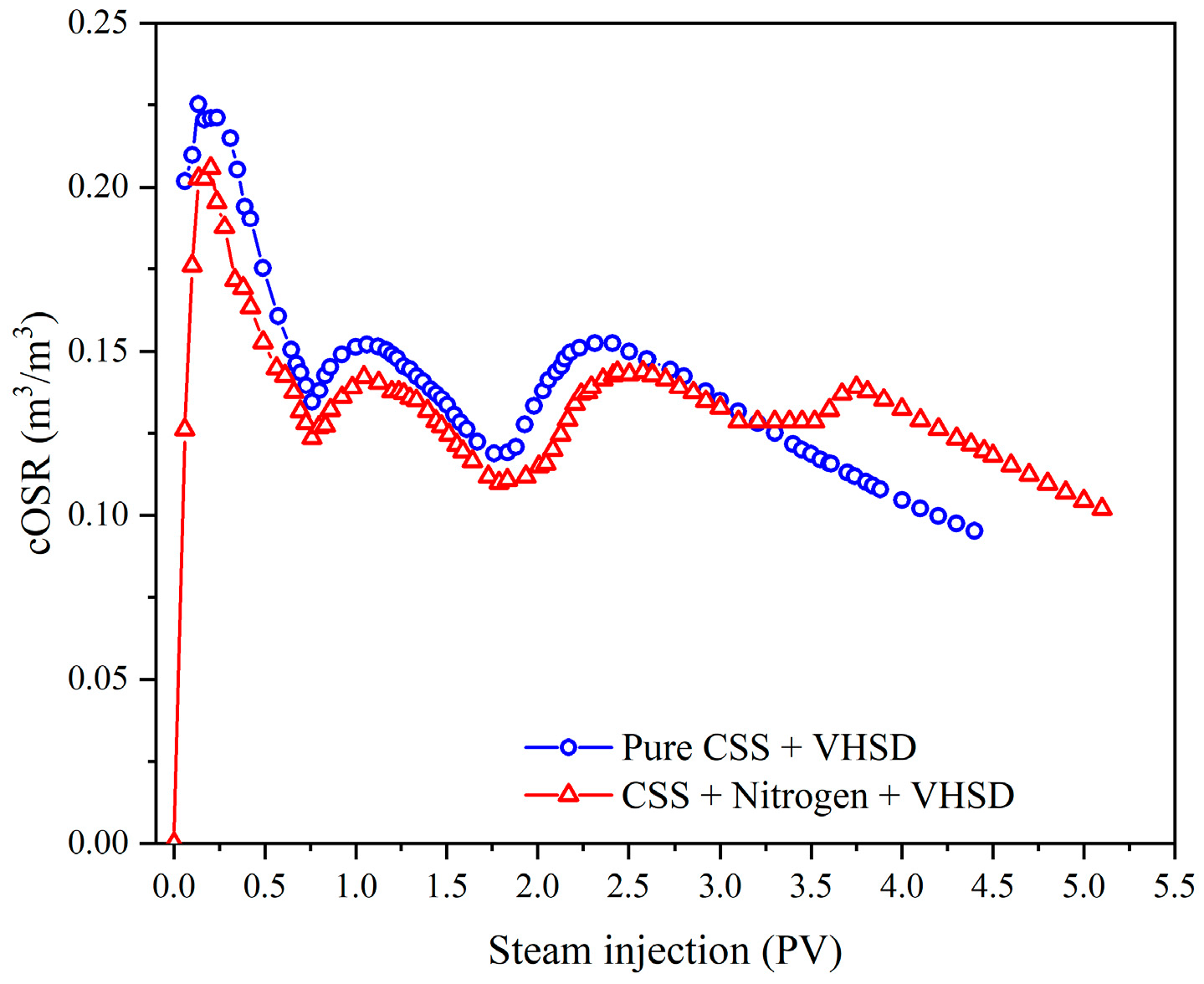



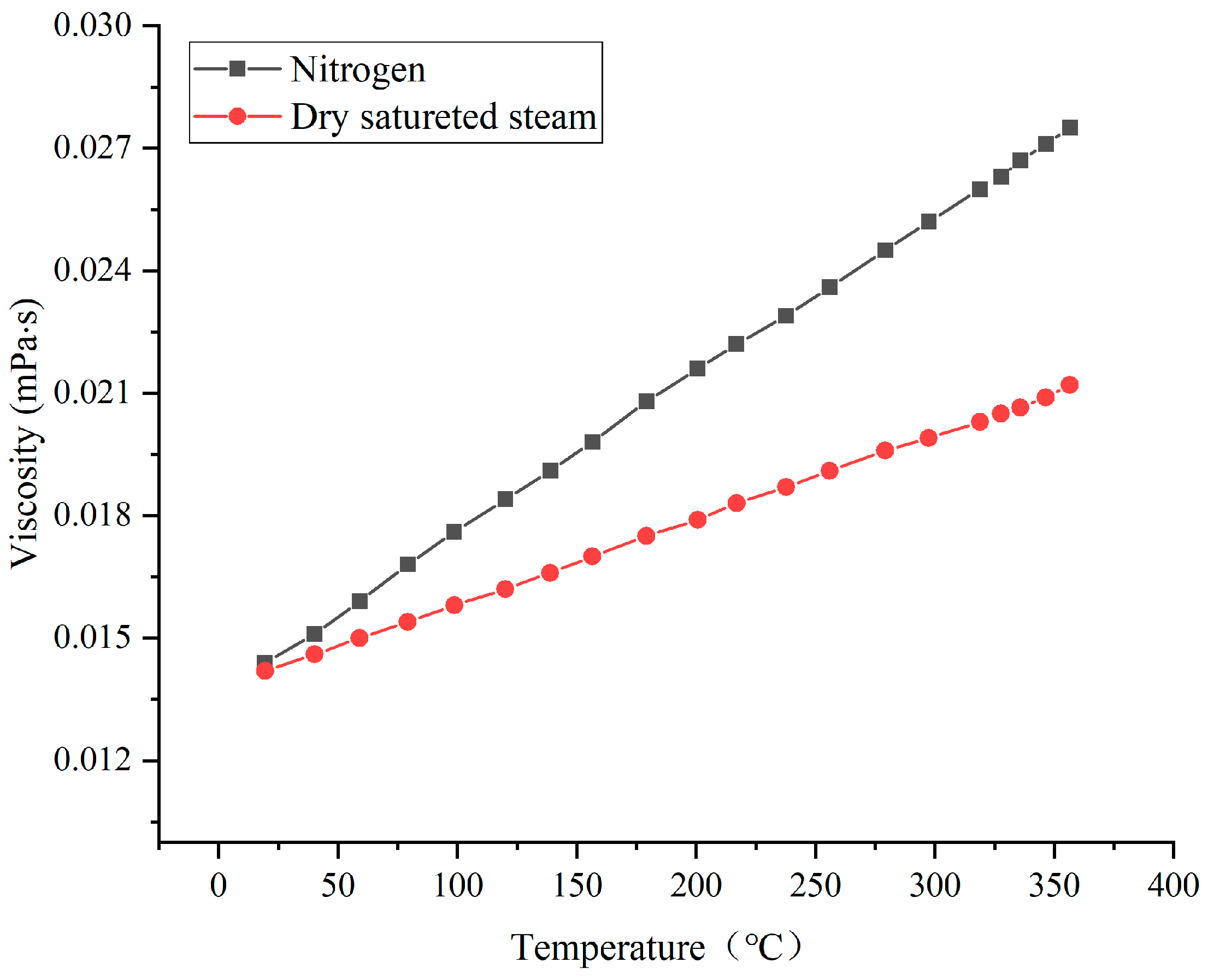



| Influencing Factor | Levels | M | |
|---|---|---|---|
| Oil layer thickness (m) | 12 | 4336.75 | 2940.744 |
| 14 | 7345.927 | ||
| 16 | 11,466.38 | ||
| 18 | 21,500.5 | ||
| 20 | 28,084.83 | ||
| 22 | 33,412.29 | ||
| Oil saturation | 0.5 | 11,934.07 | 84,764.93 |
| 0.55 | 13,841.56 | ||
| 0.6 | 16,234.32 | ||
| 0.65 | 21,146.2 | ||
| 0.7 | 27,188.67 | ||
| 0.75 | 31,841.42 | ||
| 0.8 | 37,363.55 | ||
| PIR | 1.05 | 14,709.18 | 46,897.25 |
| 1.1 | 17,031.85 | ||
| 1.2 | 21,360.27 | ||
| 1.3 | 26,455.69 | ||
| Steam temperature (°C) | 220 | 19,541.99 | 11.89169 |
| 240 | 20,086.57 | ||
| 260 | 19,917.1 | ||
| 280 | 19,934.05 | ||
| 300 | 20,493.33 | ||
| Steam quality | 0.6 | 52,003.7 | 14,331.39 |
| 0.7 | 47,440.8 | ||
| 0.8 | 45,470.5 |
| Serial Number | Oil Layer Thickness (m) | PIR | Steam Quality | Oil Saturation | Steam Temperature (°C) | Breakthrough Time | M |
|---|---|---|---|---|---|---|---|
| 1 | 12 | 1.2 | 0.8 | 0.8 | 240 | 18-Aug-2023 | 47,130.56 |
| 2 | 18 | 1.1 | 0.6 | 0.6 | 240 | 22-Jun-2028 | 15,061.66 |
| 3 | 12 | 1.2 | 0.6 | 0.7 | 260 | 24-Apr-2023 | 5135.289 |
| 4 | 18 | 1.02 | 0.6 | 0.8 | 220 | 25-Feb-2028 | 14,164.88 |
| 5 | 12 | 1.3 | 0.7 | 0.6 | 220 | 24-Jun-2023 | 30,161.33 |
| 6 | 22 | 1.02 | 0.6 | 0.5 | 300 | 2-Apr-2028 | 8062.862 |
| 7 | 12 | 1.3 | 0.6 | 0.7 | 300 | 27-Aug-2023 | 32,198.33 |
| 8 | 12 | 1.02 | 0.7 | 0.6 | 260 | 15-Jul-2023 | 24,859.21 |
| 9 | 18 | 1.02 | 0.7 | 0.7 | 280 | 18-May-2026 | 17,168.36 |
| 10 | 16 | 1.3 | 0.6 | 0.8 | 280 | 10-Jan-2025 | 37,604.71 |
| 11 | 22 | 1.2 | 0.6 | 0.6 | 280 | 11-Jun-2028 | 21,435.23 |
| 12 | 16 | 1.1 | 0.6 | 0.5 | 260 | 26-Jun-2023 | 15,556.46 |
| 13 | 16 | 1.02 | 0.8 | 0.6 | 300 | 17-Aug-2024 | 13,015.4 |
| 14 | 16 | 1.2 | 0.7 | 0.5 | 220 | 13-Aug-2024 | 12,192.13 |
| 15 | 18 | 1.2 | 0.7 | 0.5 | 300 | 3-May-2025 | 12,285.01 |
| 16 | 22 | 1.3 | 0.7 | 0.5 | 240 | 31-Oct-2026 | 16,048.23 |
| 17 | 18 | 1.3 | 0.8 | 0.5 | 260 | 29-Aug-2024 | 14,685.22 |
| 18 | 22 | 1.1 | 0.8 | 0.7 | 220 | 14-Sep-2027 | 28,053.29 |
| 19 | 12 | 1.1 | 0.7 | 0.5 | 280 | 14-Jul-2023 | 17,964.59 |
| 20 | 12 | 1.02 | 0.8 | 0.5 | 280 | 27-Jun-2023 | 18,488.32 |
| 21 | 16 | 1.02 | 0.7 | 0.7 | 240 | 7-Feb-2025 | 16,867.82 |
| 22 | 22 | 1.02 | 0.7 | 0.8 | 260 | 10-Jul-2028 | 34,756.96 |
| 23 | 12 | 1.02 | 0.6 | 0.5 | 240 | 10-Aug-2023 | 15,033 |
| 24 | 12 | 1.02 | 0.6 | 0.5 | 220 | 20-Aug-2023 | 14,466.26 |
| 25 | 12 | 1.1 | 0.7 | 0.8 | 300 | 6-Sep-2023 | 41,338.7 |
| After Adjustment | Before Adjustment | ||
|---|---|---|---|
| Model Time /min | Actual Time /a | Model Time /min | Actual Time /a |
| 60 | 4.208 | 60 | 0.17 |
| Experimental Scheme | Pore Volume (cm3) | Saturated Oil (mL) | Oil Saturation (%) |
|---|---|---|---|
| Steam | 3259 | 2300 | 70.6 |
| Steam + N2 assistant | 3243 | 2309 | 71.2 |
| Physical Significance | Reservoir Parameter Values | Model Parameter Values | Comments |
|---|---|---|---|
| Reservoir thickness (m) | 20.38 | 0.35 | Geometric similarity criterion |
| Distance of injection and production well (m) | 5 | 0.05 | |
| Vertical well separation (m) | 70 | 0.07 | |
| Perforation thickness of vertical well (m) | 10 | 0.01 | |
| Average porosity (%) | 30.35 | 31.7 | Equal |
| Average permeability (mD) | 985 | 24783 | Permeability similarity model |
| Oil saturation (%) | 71 | 70 | Equal |
| Viscosity of degassed crude oil at 50 °C (mPas) | 9930 | 9930 | |
| Oil density at 50 °C (kg/m3) | 984.1 | 984.1 | |
| Steam injection rate (t/d, mL/min) | 130 | 34.0 | The model steam injection rate is calculated based on the steam quality, perforation thickness, and the vertical well injection rate of 130 t/d |
| Steam quality | 0.8 | 0.8 | Equal |
| Time (a, min) | 4.21 | 60 | Modified time similarity model |
| Volume of nitrogen injected during the first round (m3, Ncm3) | 28,000–32,000 | 530–605 | According to the proportional transformation of the model volume |
| Average horizon section length of the steam absorption (m) | 200 | 0.025 | Based on the interpretation report of the wellbore temperature profile test |
Disclaimer/Publisher’s Note: The statements, opinions and data contained in all publications are solely those of the individual author(s) and contributor(s) and not of MDPI and/or the editor(s). MDPI and/or the editor(s) disclaim responsibility for any injury to people or property resulting from any ideas, methods, instructions or products referred to in the content. |
© 2024 by the authors. Licensee MDPI, Basel, Switzerland. This article is an open access article distributed under the terms and conditions of the Creative Commons Attribution (CC BY) license (https://creativecommons.org/licenses/by/4.0/).
Share and Cite
Zheng, A.; Yu, C.; Huang, H.; Li, X.; Liu, H.; Li, T.; Song, D.; Liu, Y.; Wang, P.; Liang, X. Study on Characteristics of Steam Chamber and Factors Influencing Nitrogen-Assisted Vertical–Horizontal Steam Drainage Development. Processes 2024, 12, 754. https://doi.org/10.3390/pr12040754
Zheng A, Yu C, Huang H, Li X, Liu H, Li T, Song D, Liu Y, Wang P, Liang X. Study on Characteristics of Steam Chamber and Factors Influencing Nitrogen-Assisted Vertical–Horizontal Steam Drainage Development. Processes. 2024; 12(4):754. https://doi.org/10.3390/pr12040754
Chicago/Turabian StyleZheng, Aiping, Chunsheng Yu, Houchuan Huang, Xuan Li, Huan Liu, Tianxiu Li, Dong Song, Yili Liu, Pan Wang, and Xiangjin Liang. 2024. "Study on Characteristics of Steam Chamber and Factors Influencing Nitrogen-Assisted Vertical–Horizontal Steam Drainage Development" Processes 12, no. 4: 754. https://doi.org/10.3390/pr12040754




